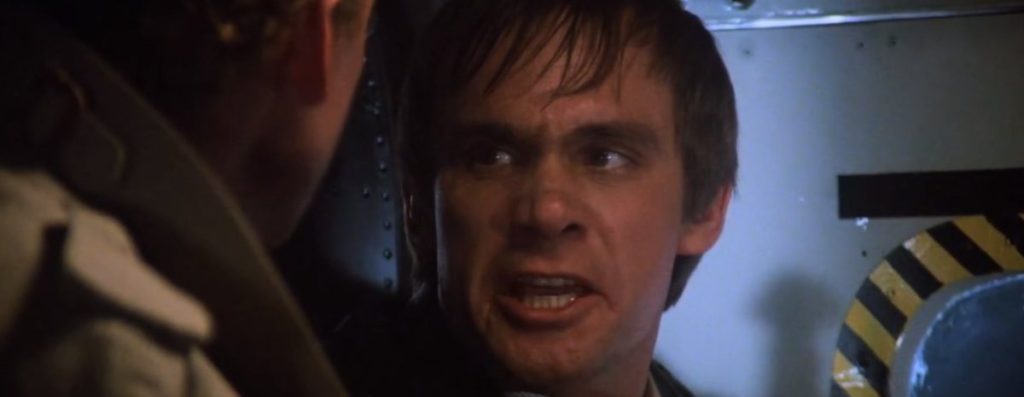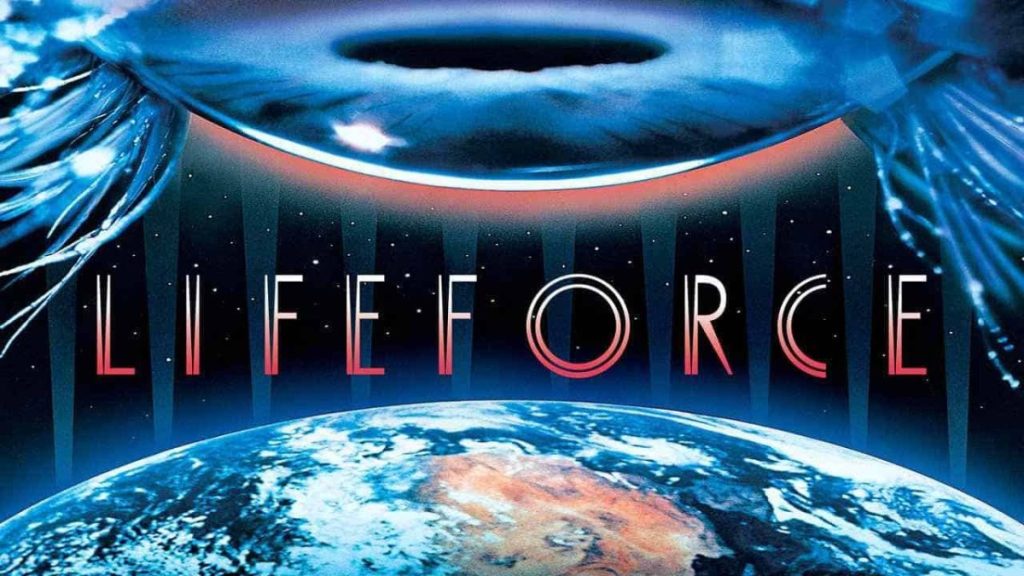Amongst horror fans, Lifeforce remains one of the most tragically underseen gems of the 1980s horror boom. Directed by genre maverick Tobe Hooper hot on the heels of Poltergeist, this eccentric sci-fi vampire tale failed to make a major splash upon release but has gone on to earn a devoted cult following. Blending space opera, body horror, apocalyptic thrills, and erotic overtones, Lifeforce offers a smorgasbord of outlandish delights awaiting rediscovery by curious horror devotees.
Despite a talented cast including Steve Railsback, Peter Firth, and Mathilda May, plus impressive Oscar-nominated special effects, Lifeforce never caught on with mainstream audiences in 1985. The film’s surrender to absurdity and overt sexuality proved overzealous for casual moviegoers at the time. Yet for those with an appetite for the strange and sublime, Lifeforce remains an essential viewing experience.
The premise alone situates Lifeforce as a peak ’80s genre mashup. After discovering dormant bat-like creatures and a beautiful female humanoid on board a derelict spaceship, a crew returns home to London unaware they’ve imported an alien scourge. May’s seductive space vampire soon escapes confinement, creating an apocalyptic plague of bloodsuckers that only Railsback’s stoic hero can stop.
Lifeforce was not a mainstream horror movie
Though mainstream audiences didn’t know what to make of Lifeforce upon release, the film’s genre blending and excessive flair anticipate so much of today’s horror landscape. With its mixing of sci-fi, gothic horror, eroticism, and apocalyptic frenzy, Lifeforce contains strands of DNA that prefigure the works of filmmakers like Guillermo del Toro. The film’s cautionary tale about deadly pathogens entering human hosts via space travel oddly foreshadows more recent events as well.
Lifeforce liberally combines old-school creature effects and gruesome maimings that evoke classic Hammer Studios productions. Yet the psychedelic intensity and physco-sexual undertones peer years ahead to the works of Clive Barker and David Cronenberg. Where hunky Chris Hemsworth now winks through Ghostbusters, Mathilda May’s fully nude (yet never exploitative) performance pushed major boundaries in 1985. She’s a sultry force of destruction far removed from Hollywood norms.
Lifeforce indulges wildly imaginative ideas and visuals that would influence horror’s eventual embrace of the strange. The film’s varied horror elements shouldn’t mesh smoothly, yet they’re anchored by an apocalyptic urgency and mythic undertones. As a bridging force between classic horror traditions and boundary-pushing ‘80s excess, Lifeforce deserves recognition for its role in horror’s creative evolution. Tobe Hooper took daring risks to expand genre borders.

Tobe Hooper A Genre Trend Setter
While Lifeforce is atypical compared to more straightforward terror tales like The Texas Chain Saw Massacre, Tobe Hooper’s willingness to get weird epitomizes his maverick filmmaking spirit. Having exploded into the horror scene with his iconic slasher debut, Hooper spent the ‘80s and ‘90s embracing creative freedom and diverse projects. From weirdo Stephen King adaptation Salem’s Lot to aliens run amok in Invaders from Mars, he followed his idiosyncratic muse.
Lifeforce encapsulates Hooper’s irreverent perspective on genre entertainment. He stuffs the frame with odd detours like zoomed-in shots of writhing lab rats and an entire subplot about naked vampire ghosts roaming London. Moments of body horror intensity punctuate the loopy plot progression. Only Hooper would think to set the climax aboard an ancient alien spacecraft designed by H.R. Giger, awash in gothic gloom.
While the director is better known for The Texas Chainsaw Massacre’s brutality, Lifeforce shows he could transcend expectations. The film’s Xbox huge budget and marketing aimed for blockbuster status, but Hooper remained dedicated to his macabre vision. Lifeforce melds old-school creature effects and operatic scopes with taboo nudity and psychedelic sparks.
30-plus years later, unorthodox genre crossbreeds like Lifeforce feel common, but Hooper’s willingness to shatter molds was ahead of its time. Whether or not the assemblage works for all viewers, the director followed his own demented muse. For audiences craving creatures and chaos, Lifeforce remains an off-kilter treat from one of horror’s most fascinating iconoclasts.

The cinematography of Lifeforce was Top Notch
Matching the film’s grandiose themes, Lifeforce boasts arresting cinematography that expands its sci-fi horror scope. The film cost a mind-boggling $25 million in 1985 dollars, and the budget allows for epic set pieces and effects. Combining these meticulously crafted elements with unconventional camerawork, Hooper creates chilling imagery that sticks with viewers.
Cinematographer Alan Hume had shot Lewis Gilbert’s James Bond entries as well as the 1976 supernatural chiller The Omen. His experience capturing stunning compositions transfers seamlessly to Lifeforce’s ambitious scale. From the discovery of the alien spacecraft to the glowing energy fields to London burning, Hume makes every scene visually impactful.
Unique POV shots from the bats’ perspective and macro close-ups flesh out the layer of creature effects. When the vampire ghosts aren’t causing chaos, deep focus and symmetrical framing reflect the gothic sensibilities. The film’s most surreal moments, like Dr. Armstrong’s psychic trip through the alien ship, convey psychedelic sensations through warpingcamera effects and rapid montage.
Lifeforce displays the high-quality craftsmanship and masterful lighting that define the most memorable fantasy/horror epics. While critics justly criticized the jumbled plotting and disjointed pacing, none could argue that the film didn’t push its budget to the limits. Hume’s skilled lensing matched with unconventional tricks capture the nightmarish mayhem in vivid detail. For visual spectacle alone, Lifeforce deserves more praise than its reputation affords.
Final Thoughts on LifeForce
Though initially met with indifference, Lifeforce deserves renewed appreciation for its wealth of imagination and distinct visual craft. Tobe Hooper took his career to delightfully weird new heights by meshing classic gothic horror and erotic Feeders with apocalyptic sci-fi on a lavish scale. The storytelling can’t always keep up with the breadth of ideas, but the filmmaking itself displays masterful chops. Striking camerawork and effects expansively render a bizarre premise that only could have emerged from the 1980s.
Lifeforce remains such an oddity that each viewer’s mileage may vary. Those with a taste for the outlandish will discover a gem, while more straitlaced horror fans might recoil from the bedlam. Regardless, Hooper’s courage to go for broke and surrender fully to macabre camp yields fascinating results. For followers of weird cinema, it’s an essential experience on par with cult favorites like Hellraiser and The Lost Boys.
Though hampered by shortcomings in narrative focus, Lifeforce triumphs on the merits of visual imagination and ceaseless creative energy. It’s a testament to Hooper’s willingness to think outside restrictive boxes. For delivering such a feast for the eyes and senses, Lifeforce earns 4 out of 5 Scream Masks. Revisit this unique sci-fi horror spectacle and appreciate it as an influential precursor to horror’s future.
Where you can Stream Lifeforce for free in HD
Want to revisit Tobe Hooper’s oddball cult classic for yourself? Luckily, Lifeforce is currently available to watch for free on a couple of streaming services.
Horror fans can find Lifeforce ready to stream on Tubi. As long as you don’t mind some commercial breaks, you can watch Mathilda May bring apocalyptic space vampire mayhem to 1980s London. Tubi is supported on a wide range of devices.
For another free option, Pluto TV has Lifeforce in its on-demand library. Pluto TV does require you to create an account, but then you can watch Steve Railsback battle bloodsucking ghouls to your heart’s content. The ad-supported service is available on platforms like Roku and Fire TV.
So fire up Tubi or Pluto TV to revisit one of Tobe Hooper’s most imaginatively bizarre trips into sci-fi horror weirdness. Marvel at the visual craft and kinky originality that make Lifeforce such a cult treasure. Just be warned, once you’ve had a taste of Mathilda May’s sultry extraterrestrial, regular vampires might feel a bit vanilla!

